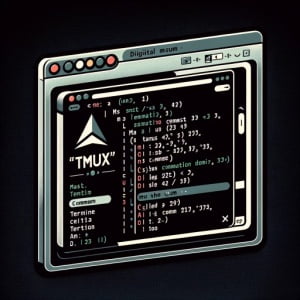Using ‘tmux’ Command For Multitasking in Linux

Are you finding it difficult to manage multiple terminal sessions in Linux? You’re not alone. Many developers find themselves in a juggling act, trying to keep track of multiple sessions, but there’s a tool that can simplify this process.
The ‘tmux’ command can handle multiple sessions with ease. It’s a powerful utility that allows you to manage and control multiple terminal sessions from a single screen. With tmux, you can switch between sessions, detach and reattach to sessions, and even split your screen into multiple panes for simultaneous viewing.
This guide will walk you through the basics of the tmux command in Linux, all the way to advanced usage and troubleshooting. We’ll cover everything from starting a new tmux session, detaching and reattaching to sessions, creating windows and panes, to customizing your tmux environment. We’ll also discuss alternative approaches and provide solutions to common issues you might encounter while using tmux.
So, let’s dive in and start mastering tmux!
TL;DR: How Do I Use the Tmux Command in Linux?
To start a new tmux session, simply type
tmuxin your terminal.This command initiates a new session where you can manage multiple terminal tasks simultaneously. You can also customize your sessions with arguments.
Here’s a basic example:
tmux -s mysession
This command will start a new tmux session. Once inside a tmux session, you can run your commands, create new windows, and even split your screen into multiple panes.
# Inside a tmux session
ls -l
In this example, we’ve started a tmux session and executed the ls -l command, which lists the contents of the current directory in a long format.
This is just the beginning of what you can do with the tmux command in Linux. Continue reading to explore more advanced usage, tips, and troubleshooting advice.
Table of Contents
Getting Started with Tmux
The tmux command in Linux is a powerful tool that lets you manage multiple terminal sessions within a single window. Here, we will cover how to start, detach, and reattach to tmux sessions.
Starting a Tmux Session
To start a new tmux session, simply type tmux new -s mysession. This command initiates a new session named ‘mysession’.
tmux new -s mysession
This will create a new tmux session named ‘mysession’. You can verify this by typing tmux ls in the terminal, which lists all the current tmux sessions.
tmux ls
The output should display ‘mysession’ among the list of active tmux sessions.
Detaching from a Tmux Session
To detach from a tmux session, press Ctrl+b and then d. This key combination allows you to leave the session without terminating it.
# Inside a tmux session
Ctrl+b, d
After pressing these keys, you will be returned to your normal terminal session. The tmux session ‘mysession’ is still running in the background.
Reattaching to a Tmux Session
To reattach to an existing tmux session, use the command tmux attach -t mysession.
tmux attach -t mysession
This will bring you back to the ‘mysession’ tmux session, exactly where you left off.
By mastering these basic tmux commands, you can effectively manage your terminal sessions in Linux. In the next section, we’ll delve into more advanced usage of tmux.
Advanced Usage and Techniques for Tmux
As you become more comfortable with the basic usage of tmux, you can start to explore its more advanced features. These include creating windows and panes, switching between them, and customizing the tmux environment.
Before we dive into the advanced usage of tmux, let’s familiarize ourselves with some of the command-line arguments or flags that can modify the behavior of the tmux command. Here’s a table with some of the most commonly used tmux arguments.
| Argument | Description | Example |
|---|---|---|
-t | Target an existing session, window, or pane | tmux ls -t mysession |
-n | Specify a name for a new session or window | tmux new -n mywindow |
-d | Detach a client from a session | tmux detach -d myclient |
-l | List all clients attached to a session | tmux lsc -l |
-s | Create a new session | tmux new -s mysession |
-b | Bind a key to a command | tmux bind -b 'C-a' send-keys 'C-a' |
-r | Remove a key binding | tmux unbind -r 'C-b' |
-c | Change the current directory | tmux new -c /home/user |
-f | Specify a configuration file | tmux start-server -f /etc/tmux.conf |
-L | Specify a socket name | tmux -L mysocket |
Now that we have a basic understanding of tmux command line arguments, let’s dive deeper into the advanced use of tmux.
Creating Windows and Panes
One of the powerful features of tmux is the ability to create multiple windows and panes within a single session. This allows you to run and monitor multiple tasks simultaneously. To create a new window within a session, use the command tmux new-window.
tmux new-window
This command creates a new window within the current tmux session. You can switch between windows using Ctrl+b n for the next window and Ctrl+b p for the previous window.
To split a window into multiple panes, you can use Ctrl+b % for a vertical split and Ctrl+b " for a horizontal split.
# Inside a tmux session
Ctrl+b, %
Ctrl+b, "
This will split the current window into multiple panes. You can switch between panes using Ctrl+b arrow keys.
Customizing Tmux Environment
Tmux allows you to customize your environment to suit your preferences. You can change the color scheme, set the status bar, bind keys to commands, and much more. All these customizations can be done in the tmux configuration file .tmux.conf located in your home directory.
For example, to change the color scheme, you can add the following lines to your .tmux.conf file.
# Inside .tmux.conf
set -g default-terminal 'screen-256color'
set -g status-bg '#000000'
set -g status-fg '#ffffff'
This will set the terminal to use a 256 color scheme and change the status bar to black with white text.
By mastering these advanced tmux commands, you can effectively manage and customize your terminal sessions in Linux. In the next section, we’ll discuss alternative approaches and provide solutions to common issues you might encounter while using tmux.
Exploring Alternatives to Tmux
While tmux is a powerful and popular terminal multiplexer, it’s not the only option available. Other terminal multiplexers, such as Screen and Byobu, also offer robust features for managing multiple terminal sessions.
Screen: The Veteran Terminal Multiplexer
Screen is one of the oldest terminal multiplexers available for Linux. Like tmux, it allows you to create, detach, and reattach to sessions. However, its interface and commands are different.
To start a new Screen session, you can use the command screen.
screen
This command starts a new Screen session. To detach from a Screen session, you can press Ctrl+a followed by d.
# Inside a Screen session
Ctrl+a, d
To reattach to a Screen session, you can use the command screen -r.
screen -r
This command reattaches to the detached Screen session.
Byobu: The User-Friendly Terminal Multiplexer
Byobu is another terminal multiplexer that offers a more user-friendly and visually appealing interface. It’s actually a wrapper for tmux and Screen, meaning it uses these tools under the hood while providing its own interface.
To start a new Byobu session, you can use the command byobu.
byobu
This command starts a new Byobu session. To detach from a Byobu session, you can press F6.
# Inside a Byobu session
F6
To reattach to a Byobu session, you can use the command byobu again.
byobu
This command reattaches to the detached Byobu session.
Making the Right Choice
While tmux, Screen, and Byobu all offer similar functionality, they each have their unique features and use cases. Tmux is highly customizable and powerful, making it a favorite among power users. Screen, being one of the oldest terminal multiplexers, is widely supported and stable. Byobu, with its user-friendly interface, is great for beginners or those who prefer a more visual interface.
When choosing a terminal multiplexer, consider your needs, preferences, and the specific features of each tool. Regardless of your choice, mastering a terminal multiplexer is a valuable skill for any Linux user.
Troubleshooting Tmux: Common Issues and Solutions
While tmux is a powerful tool, like any software, you might encounter some issues while using it. Here, we’ll discuss some of the common problems and how to troubleshoot them. We’ll also share some best practices for using tmux effectively.
Tmux Session Disappearing After Closing Terminal
One common issue is that your tmux session disappears after closing the terminal. This happens because closing the terminal also terminates the shell process, which in turn kills the tmux server and all its sessions.
To keep your tmux sessions running even after closing the terminal, you need to detach from the tmux session before closing the terminal. You can do this by pressing Ctrl+b followed by d.
# Inside a tmux session
Ctrl+b, d
This command detaches you from the tmux session but keeps it running in the background.
Tmux Session Not Resizing Properly
Another common issue is that tmux sessions do not resize properly when you resize the terminal window. This can be fixed by forcing tmux to resize to the current terminal window size using the command tmux attach -d.
tmux attach -d
This command attaches to the last tmux session and detaches all other clients, forcing tmux to resize to the current terminal window size.
Tmux Key Bindings Not Working
Sometimes, tmux key bindings might not work as expected. This could be due to conflicts with other software or incorrect configuration. To troubleshoot this, you can check your tmux configuration file .tmux.conf for any errors or conflicts.
cat ~/.tmux.conf
This command displays the content of your tmux configuration file. Look for any incorrect or conflicting key bindings.
Best Practices for Using Tmux
Here are some tips for using tmux effectively:
- Detach from sessions when not in use to keep them running in the background.
- Customize your tmux environment to suit your needs. You can change the color scheme, set the status bar, bind keys to commands, and much more.
- Use tmux sessions to organize your work. For instance, you can have one session for coding, another for debugging, and another for documentation.
By understanding these common issues and best practices, you can make the most out of the tmux command in Linux.
Understanding Terminal Multiplexers
Terminal multiplexers are powerful tools that allow you to manage multiple terminal sessions within a single window. They are particularly useful in scenarios where you need to run multiple commands or tasks simultaneously, monitor their output, and switch between them efficiently.
Why Use Terminal Multiplexers?
Imagine you’re connected to a remote server, running a long task that you need to monitor. Suddenly, your connection drops. Without a terminal multiplexer, your task would stop, and you’d have to start over. However, with a terminal multiplexer like tmux, your task keeps running. You can simply reattach to the tmux session and pick up where you left off.
Terminal multiplexers also allow you to split your terminal window into multiple panes and run different tasks in each pane. This is incredibly useful for multitasking or monitoring multiple tasks at once.
tmux new-session -s multitask
# Inside tmux session
Ctrl+b, %
Ctrl+b, "
In this example, we first create a new tmux session named ‘multitask’. Then, inside the tmux session, we split the window into multiple panes using Ctrl+b, % for a vertical split and Ctrl+b, " for a horizontal split.
The Concept of Sessions, Windows, and Panes in Tmux
In tmux, a session is a single collection of pseudo-terminals under the management of tmux. Each session has one or more windows linked to it. A window occupies the entire screen and can be split into rectangular panes, each of which is a separate pseudo-terminal.
- Session: A session is a group of windows. You can think of a session as a separate workspace.
Window: A window is a single screen covered with one or more panes. Each window has a status line, which displays information about the window.
Pane: A pane is a rectangular part of a window that runs a specific command, like a shell.
These concepts form the foundation of tmux’s functionality and versatility. By understanding them, you can better utilize tmux and manage your terminal sessions more effectively.
Real-World Scenarios with Tmux
The power of tmux becomes truly apparent when applied to real-world scenarios. In this section, we’ll explore how tmux can be used for remote server management and handling long-running tasks.
Tmux for Remote Server Management
When managing remote servers, tmux can be a lifesaver. Imagine you’re connected to a remote server via SSH and your connection drops. Without tmux, you would lose all your work. But with tmux, you can simply reattach to the tmux session and continue where you left off.
Here’s an example of how you can use tmux for remote server management:
ssh user@remote-server
# Inside remote server
tmux new -s server-management
In this example, we first connect to the remote server via SSH. Then, inside the remote server, we start a new tmux session named ‘server-management’. Now, even if our SSH connection drops, we can simply reconnect and reattach to the ‘server-management’ tmux session.
Tmux for Long-Running Tasks
Tmux is also incredibly useful for running long tasks. You can start a long task inside a tmux session, detach from the session, and the task will continue running in the background.
Here’s an example of how you can use tmux for long-running tasks:
tmux new -s long-task
# Inside tmux session
./run-long-task.sh
# Detach from session
Ctrl+b, d
In this example, we first start a new tmux session named ‘long-task’. Then, inside the tmux session, we run a long task (in this case, a shell script named ‘run-long-task.sh’). Finally, we detach from the tmux session. The long task will continue running in the background, even if we close the terminal.
Further Resources for Tmux Mastery
To deepen your understanding of tmux and its applications, consider exploring the following resources:
- The Tao of Tmux: This online book provides a thorough guide to tmux, from basic usage to more advanced topics.
Tmux GitHub Repository: The official tmux GitHub repository contains the source code of tmux, as well as a wealth of information in its wiki and issue tracker.
Tmux: Productive Mouse-Free Development: This book by Brian P. Hogan provides practical examples and clear explanations to help you become more productive with tmux.
Wrapping Up: Mastering the Tmux Command in Linux
In this comprehensive guide, we’ve navigated through the intricate world of tmux, a terminal multiplexer that allows you to manage multiple terminal sessions within a single window in Linux.
We started with the basics, learning how to start, detach, and reattach to tmux sessions. We then delved into more advanced usage, exploring how to create windows and panes, switch between them, and customize the tmux environment. Along the way, we tackled common issues that you might face when using tmux, such as disappearing sessions and resizing problems, providing solutions and best practices for each issue.
We also ventured into alternative terminal multiplexers, comparing tmux with other tools like Screen and Byobu. Here’s a quick comparison of these tools:
| Tool | Flexibility | Usability | Customization |
|---|---|---|---|
| Tmux | High | Moderate | High |
| Screen | Moderate | Moderate | Low |
| Byobu | High | High | Moderate |
Whether you’re a beginner just starting out with tmux, or an experienced user looking to deepen your understanding, we hope this guide has provided you with valuable insights and practical advice for using the tmux command in Linux.
The ability to manage multiple terminal sessions effectively is a crucial skill for any Linux user. With tmux, you can streamline your workflow, increase your productivity, and take your terminal skills to the next level. Happy multiplexing!

